Genre: Action Developer: WJS Design Publisher: Electronic Arts Players: 1 Released: 1991
In 1989, Psygnosis released a game for the Amiga that became a huge hit for that computer. Called Shadow of the Beast, the game featured a fantastic musical score, gorgeous graphics, and a difficulty level that made it a tough challenge to beat. Two years after its release, Electronic Arts brought the game to the Sega Genesis. Using 8Mb of “ultra-compression” memory, they sought to replicate the experience that so many Amiga owners had been enjoying. Did they succeed? Read on.
One night many years ago, a small child was stolen away from his parents. Taken to the temple Necropolis, he was turned over to the Mages of Darkness. These warrior priests of the Beast Lord transformed him into a hideous monster using secret potions created from the blood of rare creatures. Though he gained amazing strength, agility and power, the Mages erased all of his memories, and put him to work as the Messenger of the Beast. You were that small child. And now, after numerous years of service, your memories have come flooding back, revealing the truth about what had been done to you. With only revenge in mind, you turn against those who made you what you are and seek to destroy them all.
The original Amiga game was praised for its graphics, and the Genesis version does a pretty good job in this area. The parallax scrolling is there, the diverse locales are there, the animation quality of the characters is there, and the amount of colors on-screen does a respectable job recreating the Amiga version. There is some color loss/changes due to the Genesis color pallet, which results in the contrast levels being upped a bit. This gives the Genesis game a slightly less muted appearance when compared to the Amiga original. Some of the graphics have also been redesigned or re-shaded a little, but the surrealistic visual style, and the nice amount of graphical detail, still shines through in the mountains, trees, enemies, and such. So basically, the gist of the game is there visually, making it a pretty solid (but not perfect) graphical port.
When it comes to sound… well, I’ll just get to the point. It’s bad. Bad enough that you have to wonder if the person who programmed it still has a job making games. The beautiful and atmospheric Amiga soundtrack was not done justice. The songs are noticeably sped up, the instruments chosen are questionable at best, the music sounds like it’s being played too loud through speakers that can’t handle the volume, and all this adds up to the nearly complete loss of everything that made the original tunes so memorable and highly regarded. Also, the sound effects are painfully few in number, and what is there, sounds rather wimpy. Basically, EA dropped the ball in this area… big time. The Genesis might not have been able to perfectly reproduce the original music, but it could sound a hell of a lot better than EA’s sad attempt.
So the audio is a bust. Is anything else wrong with the game? Well, yes. The game plays faster than the Amiga version, and this leads to problems hitting objects that already moved quickly to begin with. The hit detection isn’t too bad, but the fact that it’s not perfect stands out more thanks to the increased speed. This makes the window for hitting an object before it hits you even smaller, leading to numerous moments of “I hit that!” being yelled at the screen.
On the more minor side, there has been some trimming done to the game’s visuals and content. Little extras like the skeletons and torches embedded in the platforms of the tree were taken out, various level graphics were simplified, and some cut scenes were removed (namely, the opening and game over ones). And while none of this breaks the game, the visual trimmings are missed if you’re familiar with the Amiga original. The levels were also shortened just a bit in spots, but these areas were minor sections and don’t result in any significant level layout changes. One final note, is that the game is quite short. This may sound odd given how long it may take you to beat it, but once you learn where everything is, the game can be beaten in under twenty minutes… though that could be seen as a good or a bad thing really.
Thankfully, the gameplay is still intact. The same tools and power ups in the Amiga game are all here, and their placements are very much the same as well. So if you’re familiar with that version, you’ll have a head start in this game. For those who’ve never touched the Amiga original, Shadow of the Beast is a game where you have to get the keys, power ups, tools, and whatnot, in the proper order. If you don’t, you’ll be unable to move forward in the game, and likely die as a result. For example, if you forget to grab the wrench early on in the castle, you’ll be stuck at the control panel later on with no way to go back, and no way to turn off the force field. This is where the game’s well known difficulty comes into play, as you’ll find yourself doing a lot of trial and error, and memorization, as you explore each level. You’ll also encounter various enemy types, from small ground-based bugs, to rockets, ghosts, giant hands, and more. They’ll attack you from almost every angle, and knowing where they show up is going to be just as important to your survival as learning where all the power ups and tools are. The gameplay itself may be pretty simple (punch, kick, jump), but with the level designs, enemy patterns, and so forth, it won’t be easy to make it through.
So how do we call this game? The graphics do alright in mimicking the Amiga version, and the gameplay of the original is all there. But the botched music drags the game down a couple notches, and the hit detection/speed up combo makes the game harder than it should be. It’s not broken and unplayable, and if you turn down the volume, the game can still be reasonably enjoyable. But it’s just not the same quality experience Amiga owners got to have, and as such, comes off pretty average.
Note: I want to make a special comment about the Japanese version of this game. Basically, Victor touched up some of the graphics, added more sound effects (and better sounding ones to replace the few EA ones), and slowed down both the game (which helps with the hit detection) and the music (to match the Amiga version better). The music still basically uses the same instruments, but at least it’s at the proper tempo most of the time. As such, I’d say get the Japanese version if you really want this game for your Sega 16-bitter. You might not be able to read the short cinema bits, but I’d score that version a point higher due to the tweaks.
SCORE: 5 out of 10

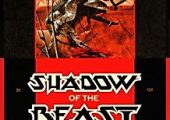
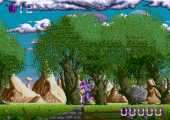
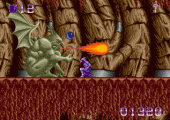
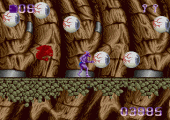
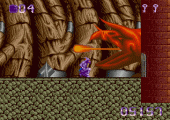
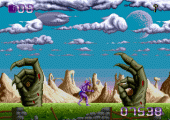
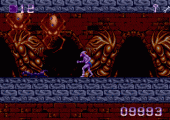
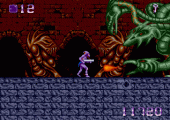
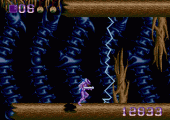
This game is the reason i bought my megadrive.
Its music, and the visual design of the stages, made it one of my favorite games ever.
Have never beaten it, but i will keep trying.
Seems to me like the hopeless quest, of a tragic doomed hero, running towards a nighmarish Lovecraftian nightmare.
First loves, sometimes are forever it seems.
The best thing about this game is the box art.
Sorry, I gotta say it: This game blows! I have strong nostalgic feelings towards it (especially the Amiga Version – the visuals are stunning, and the music is just beautiful) – but looking at it today, the gameplay just sucks, even on the home computers. The game is ridiculously hard, with powerups hidden in ridiculously obscure places, with you having no indication whatsoever where to go – You don’t even know that you need certain items at a few places to proceed (no hints are given). Heck, you start the game facing right, but you need to go left first. Imagine playing the game back in the day, with not access to the internet…
Still, back then I loved it, and I vividly remember schoolyard arguments about who had proceeded further in the game, and wild boasts about what would happen later on (which, more often than not, where outright lies). But overall, its just needlessly frustrating. But oh so beautiful! 4/10
Since I’m not familiar with the Amiga original, I can only evaluate the game on its own terms. That said, I like it a lot. It’s quite challenging, but somehow never gets too aggravating, and it’s fun to explore each stage and figure out the right approach. Whenever there’s a spot that seems borderline unfair, there’s usually a health potion nearby to soothe one’s wounded ego. The higher speed wasn’t a problem for me, nor was the music — which I enjoyed, actually. The length is just right.
It’s got some odd quirks (it’s crashed on me once or twice), and it can get a little frustrating to have to play through the first few stages over and over again. But overall, it’s one of a handful of games I’ve played recently that gives me that “one more try” feeling, and beating the game felt like a real accomplishment. 7/10.